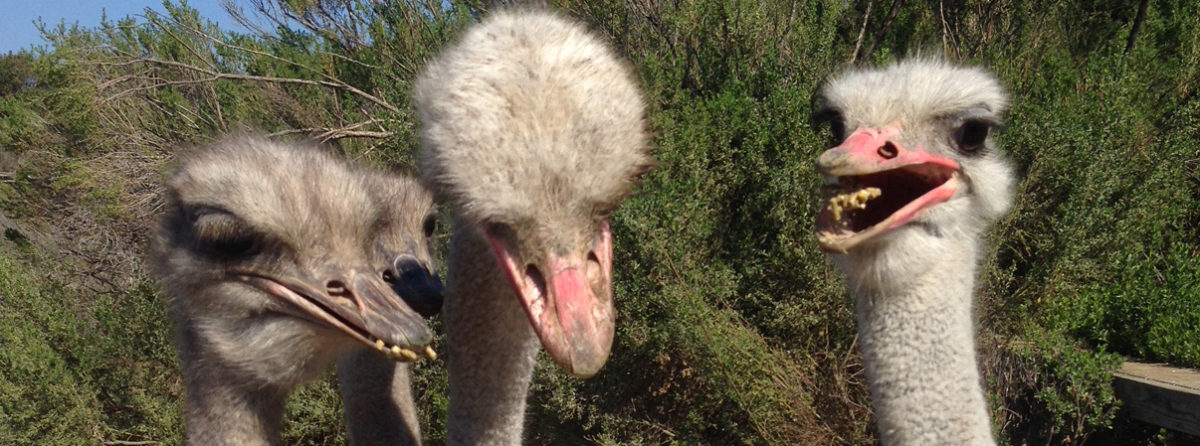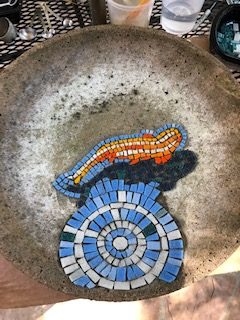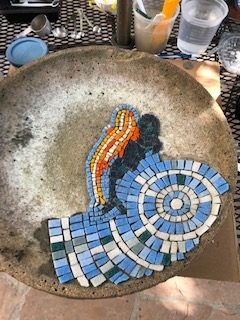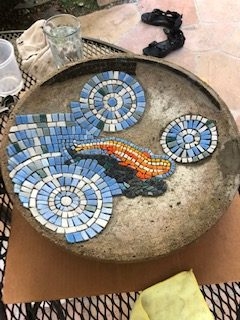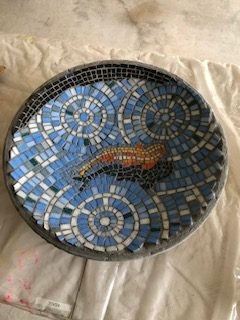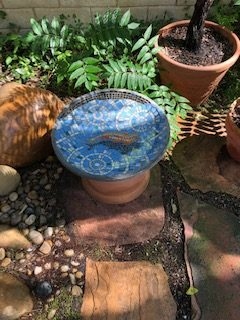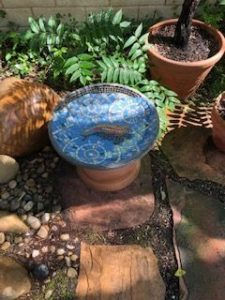 I’ve never really thought of myself as being particularly artistic and I’m certainly not patient, but for some reason I enjoy doing mosaics. A number of years ago after seeing a demo at the Getty Villa, my wife and I went to the Bay Area (closest!) to take a mosaic class. We learned the basics such as how to cut the media and how to properly grout a project. I’ve since gone on to make a half dozen or so mosaics as gifts to family or to keep for myself. I’ve wanted to do some sort of outdoor mosaic and the opportunity finally presented itself when my daughter gave me a concrete bird bath that was sitting unused in her back yard. Outdoor mosaics present a number of unique challenges. First they can’t be done on any porous material such as wood. You also can’t use the ceramic tile adhesive commonly used for indoor mosaics as the adhesive is water soluble and the tiles would fall off as the mosaic got wet. The solution is to use quikrete, a very fine concrete. It is important to wear a good quality dusk mask when you mix the quikrete with water. It was easy to mix small batches in plastic containers and the quikrete would stay viable for several hours. I also applied several applications of grout sealer to the final project.
I’ve never really thought of myself as being particularly artistic and I’m certainly not patient, but for some reason I enjoy doing mosaics. A number of years ago after seeing a demo at the Getty Villa, my wife and I went to the Bay Area (closest!) to take a mosaic class. We learned the basics such as how to cut the media and how to properly grout a project. I’ve since gone on to make a half dozen or so mosaics as gifts to family or to keep for myself. I’ve wanted to do some sort of outdoor mosaic and the opportunity finally presented itself when my daughter gave me a concrete bird bath that was sitting unused in her back yard. Outdoor mosaics present a number of unique challenges. First they can’t be done on any porous material such as wood. You also can’t use the ceramic tile adhesive commonly used for indoor mosaics as the adhesive is water soluble and the tiles would fall off as the mosaic got wet. The solution is to use quikrete, a very fine concrete. It is important to wear a good quality dusk mask when you mix the quikrete with water. It was easy to mix small batches in plastic containers and the quikrete would stay viable for several hours. I also applied several applications of grout sealer to the final project.
After I searched the internet for design inspiration (someday I hope to do a project totally on my own), I had to sketch out the central fish and shadow design on the bird bath which I had given a good cleaning with a wire brush. The fish, its shadow and the ring of blue tiles around the fish were the first things I placed. I then started the circular water patterns, taking care to leave enough room to make good decisions on how the patterns should intersect. I’m pretty happy with the results and the birds like it too! The next thing I’d like to take on is an unfinished clay chiminea. I need to look into whether a mosaic chiminea would survive repeated heating and cooling or if it would have to be decorative only.
